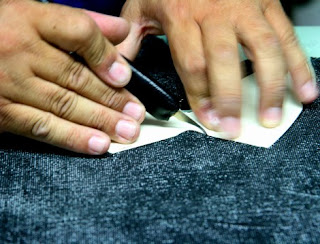The one thing that distinguishes DeeR shoes from most shoes available in the stores is that they are almost 100 percent handmade. We are pleased that we can make such a claim.
I thought it might be useful to provide a step-by-step guide as to how are shoes are made.
After your feet are measured and you decide on the basic shape and style of your shoe. Our shoemaker will select a last and create a pattern of the shoe based on your measurements. A last is chosen that is closest in measurement and shape to your foot. The last is an extremely part of the shoemaking process as it is provides the shoe with form while the shoe gets made. The last determines among other things the shape of the toe.
Once the last is selected it is placed aside to be used with the pattern and other materials required to make your shoe. A specialised worker called a "clicker"will draft a pattern on paper for the various components for the shoe and cut them out of the leather or whatever other material the upper will be made from.
The major benefit to cutting a pattern by hand is to ensure that the components cut from the hide are free of imperfections. Another benefit of hand cutting is that very little of the hide is wasted.
Once the components have been "clicked" they are passed to another specialised worker called the "closer." The closer's job is to sew or components of the upper together. This person is also responsible for applying decorations to the leather. In mens shoes these are usually medallions and broguing. Remember where I said that DeeR shoes are almost 100 percent made? Well this is the part where a machine is used.
Once this is completed the upper and the selected last are given to the "maker." This is where the shoe begins to take shape. The maker with a special plier pulls the bottom part of the upper over the last and nails it to the last. If the leather doesn't sit nicely over the last the maker will pull out the nail and re fashion the leather over the last. This process is repeated many times sometimes until the desired shape of shoe is reached.
Once the upper is sorted out and they have finished lasting it is time to attached the sole to the shoe. With some makers the sole is simply glued to the bottom. But for a more durable shoe it is necessary to attached a strip of leather between the upper and the sole. This is called the welt.
In the picture above you can see the shoe maker attaching the welt to the finished upper. By hand!!! Alot of the larger English shoe makers and places like RM Williams use a machine to perform most of the operations such as welting.
Once the welt is attached we are able to attached the sole. A channel is cut into the sole and the sole is stitched to the welt.
Now that the sole is attached the shoe is virtually finished. It just needs a heel attached and be tidied up. A heel will be attached to the sole by gluing and nailing small layers of leather together. The excess leather from the side of the sole is trimmed using a very sharp knife and a shard of glass. The side of the sole and welt are sanded, stained, painted and sealed.
I didn't have another photo showing the heel. However, you can check out a Marcel Mrsan's (who is a custom shoemaker from Hungary) Website.
Once everything is completed. The shoe is cleaned and polished up and sent to The DeeR headquarters in Brisbane.









No comments:
Post a Comment